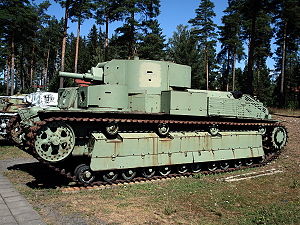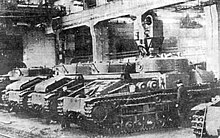T-28 (medium tank)
This article uses citations that link to broken or outdated sources. |
| T-28 | |
|---|---|
 T-28E (Finnish designation) registered as R-48, since 1943 Ps. 241-4, [1] at the Parola Tank Museum in Finland | |
| Type | Medium tank |
| Place of origin | |
| Service history | |
| In service | 1933–44 |
| Used by | Soviet Union, Finland, Hungary, Turkey (2), Nazi Germany |
| Wars | World War II |
| Production history | |
| Designed | 1931 |
| Produced | 1932–41 |
| No. built | 503 |
| Variants | T-28E, T-28 Model 1940, OT-28 |
| Specifications | |
| Mass | 28 tonnes |
| Length | 7.44 m (24 ft 5 in) |
| Width | 2.87 m (9 ft 5 in) |
| Height | 2.82 m (9 ft 3 in) |
| Crew | 6 |
| Armor | 20-30 mm |
Main armament | 76.2mm kt28 gun (70 rounds) |
Secondary armament | 3,4 or 5×7.62mm DT machine guns (8,000 rounds) |
| Engine | 45.8L Mikulin M-17 12-cylinder 500 hp (373 kW) |
| Power/weight | 18 hp/tonne |
| Suspension | twin bogies with plunger springs |
Operational range | 220 km (140 mi) |
| Maximum speed | 37 km/h (23 mph) |
The Soviet T-28 was among the world's first medium tanks. The prototype was completed in 1931 and production began in late 1932. It was an infantry-support tank intended to break through fortified defences. The T-28 was designed to complement the heavier T-35, with which it shared many components. The type would not have that much success in combat, but it played an important role as a development project for the Soviet designers. A series of new ideas and solutions were tried out on the T-28 and were later incorporated in future models.
Design history

The T-28 was in many ways similar to the British Vickers A1E1 Independent tank, which greatly influenced tank design in the period between the wars, although only one prototype was manufactured in 1926. The Kirov Factory in Leningrad began manufacturing a tank, which was based on the British Independent in 1932. The T-28 tank was officially approved on August 11, 1933. The T-28 had one large turret with a 76.2mm gun and two smaller turrets with 7.62mm machine guns. A total of 503 T-28 tanks were manufactured over a period of 8 years from 1933 to 1941.
Combat history
The T-28 was deployed during the Invasion of Poland and the Winter War against Finland. During the initial stages of the Winter War, the tank was used in direct fire missions against Finnish pillboxes. In the course of these operations it was found that the armour was inadequate and programs were initiated to upgrade it. Frontal plates were upgraded from 50 mm to 80 mm and side and rear plates to 40 mm thickness. With this up-armoured version the Red Army broke through the main Finnish defensive fortification, the Mannerheim Line.
According to Russian historian M. Kolomietz's book T-28. Three-headed Stalin's Monster, over 200 T-28s were knocked out during the Winter War, but only 20 of them were in irrecoverable losses (including 2 captured by the Finnish Army). Due to proximity of the Kirov Plant, all other knocked-out tanks were repaired, some of them over five times.[2]

The Finns knew the T-28 as the Postivaunu ("mail wagon" or stagecoach), a name which alluded to Finnish troops' discovery of Red Army field mail sacks inside the first destroyed T-28.[citation needed] Another explanation is that the high profile of the tank resembled the old west stagecoaches of the United States.[citation needed] Finns captured two T-28s during the Winter War and five in Continuation War, for a total of 7 vehicles.
The Soviets had 411 T-28 tanks when the Germans invaded the Soviet Union in June 1941.[3] Most T-28s were lost during the first two months of the invasion, many of them abandoned after mechanical breakdown. Some T-28s took part in the 1941 winter defence of Leningrad and Moscow,[4] but after late 1941, they were rare in Red Army service; a few were operated by enemy forces.[5]
Today three T-28s remain, two in Finland and one in Moscow. One restored T-28 is on display in Finnish field camouflage in the Parola Tank Museum, Finland. A further wreck is stored at Parola, now awaiting restoration and a hull previously used as a bunker was discovered near St. Petersburg
Assessment
Although the T-28 was rightly considered ineffective by 1941, it is worth remembering that when the Red Army was fielding the first T-28s in 1933, the French Army was still largely equipped with the FT-17, and the Reichswehr had no tanks at all. No army had a series-production medium tank comparable to the T-28 for several years.[citation needed]
The T-28 had a number of advanced features for the time, including radio (in all tanks) and anti-aircraft machine-gun mounts. Just before the Second World War, many received armor upgrades, bringing its protection on par with the early PzKpfw IV, although its suspension and layout were outdated.[6]
The T-28 had significant flaws. The plunger-spring type suspension was poor, but many of the better suspension designs used in World War II tanks had not yet been developed.[citation needed] The engine and transmission were troublesome. Worst of all, the design was not flexible. Although the T-28 and early PzKpfw IV were comparable in armour and firepower, the sound basic design of the PzKpfw IV allowed it to be significantly upgraded, while the T-28 was a poor basis for improvement.
Unfortunately for the Red Army, by the time the T-28 saw combat in 1939, events had overtaken it. The 1930s saw the development of the first reliable high-speed suspensions, the first purpose-designed antitank guns, and a gradual increase in the firepower of tanks. The Spanish Civil War showed that infantry units with small, towed anti-tank guns could defeat most contemporary tanks, and made the under-armoured tanks from the early 1930s particularly vulnerable.
Despite heavy losses, in the Winter War the Red Army's 20th Tank Brigade, equipped with T-28s, fulfilled its mission to break the defensive Mannerheim Line. As an infantry-support tank, designed to support infantry in breakthrough operations, the T-28 in general was successful for an early 1930s design.[citation needed]
Variants
- T-28 Model 1934 or T-28A—main production model with the same machinegun turrets, and similar main turret as the T-35 heavy tank and Model 27/32 76.2mm gun.
- T-28 Model 1938 or T-28B—version with improved L-10 76.2 mm gun (from 16.5 calibres to 26 calibres), improved gun stabilization system and improved Model M-17L engine.
- T-28E or T-28C — 1940 addition of appliqué armour in response to poor performance in Finland. Total front armour was increased to 80 mm, weight to 32 t, and road speed dropped to 23 km/h
- T-28 Model 1940 — the final batch of about twelve tanks had the same conical turret as late-production T-35 tanks.
Experimental models
Several self-propelled guns, the IT-28 bridging tank, and an engineering vehicle with mine rollers were tested on the T-28 tank chassis, but none was accepted for production. The T-29 was a prototype medium tank, a modernized T-28 with Christie suspension — a later version of this vehicle was considered for the competition of prototypes which led to the T-34, but by then it was outdated (not to be confused with a Grotte tank project also called T-29). The T-28 also served as a testbed for the KV tank suspension.
Operators
- Soviet Union
- Museums and displays on the Fussian federation: Central Armed Forces Museum. Moscow, model 1927/1932, a hull from T-28 in Museum "Sestroretsk Boundary" at industrial complex-1 "Elephant",
Beloostrov
- Finland – captured seven Soviet T-28 tanks during the Winter War and the Continuation War.
- Museums and displays in Finland: Register number Ps. 241-4 Parola Tank Museum, Ps. 241-? wreck, Ps. 241-? Mikkeli on the front yard of the former reserve non-commissioned officer school in Karkialampi near the land-force headquarters,
- Hungary – the Hungarian Army used one captured T-28 tank in the summer of 1941.[7]
- Nazi Germany – Germany captured and made operational at least one T-28 during Operation Barbarossa, designated Panzerkampfwagen T-28 746(r).[8][9]
- Turkey – According to one source, two were sold to Turkey in 1935, along with 60 T-26, five T-27 tankettes, and about 60 BA-6 armoured cars to form the 1st Tank Regiment of the 2nd Cavalry Division at Luleburgaz.[10]
- Spain – Also according to some sources, a single T-28 was sent as aid to the Republic in the Spanish Civil War during 1936–39, but its combat record is unknown.[11]
See also
Notes
- ^ http://www.andreaslarka.net/ps241004/ps241004.html
- ^ Finnish sources mention 92 destroyed T-28's during the Winter War and some tens of T-28's destroyed during the Continuation War (Kantakoski, pp. 107-108)
- ^ Kantakoski p. 108
- ^ Zaloga 1997, p
- ^ Zaloga 1997, p 13.
- ^ Zaloga 1997, p 7
- ^ Zaloga 1997, p 11.
- ^ Medium tank T-28
- ^ T-28 e-markings page 1
- ^ Zaloga 1984, p 108.
- ^ Zaloga 1984, p 109.
References
- Kantakoski, Pekka: (1998). Punaiset panssarit - Puna-armeijan panssarijoukot 1918-1945, Hämeenlinna. ISBN 978-951-98057-0-2.
- Zaloga, Steven J., James Grandsen (1984). Soviet Tanks and Combat Vehicles of World War Two, London: Arms and Armour Press. ISBN 978-0-85368-606-4.
- Zaloga, Steven J., Jim Kinnear, Andrey Aksenov & Aleksandr Koshchavtsev (1997). Soviet Tanks in Combat 1941-45: The T-28, T-34, T-34-85, and T-44 Medium Tanks, Hong Kong: Concord Publication. ISBN 978-962-361-615-7.
- Zaloga, Steven J. "Soviet Tank Operations in the Spanish Civil War", in Journal of Slavic Military Studies, vol 12, no 3, September 1999.
External links
- T-28 Medium Tank Development History and Combat Employment.
- photos and images (rkkaww2.armchairgeneral.com)
- U.S. WWII Newsmap, "Russian Armored Vehicles", hosted by the UNT Libraries Digital Collections
- Multi-turret tanks photos at War is Over
- T-28 tanks photos T-28 Tanks in museums.
